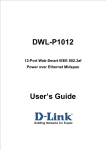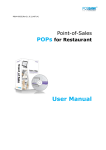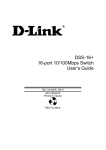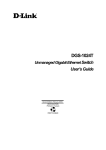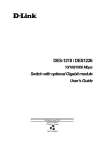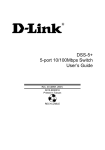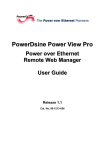Download D-Link DES-1012 User`s guide
Transcript
DWL-P1012 12-Port Web-Smart IEEE 802.3af Power over Ethernet Midspan Version 1.01 User’s Guide TABLE OF CONTENTS About This Guide ...............................................................................................1 Terms...........................................................................................................1 Overview of this User’s Guide...................................................................1 Introduction........................................................................................................1 Features.......................................................................................................2 Ports ............................................................................................................2 Unpacking and Installation ...............................................................................3 Unpacking ...................................................................................................3 Setup............................................................................................................4 Installing the DWL-P1012 on a Desktop ...................................................4 Installing the DWL-P1012 on a Rack.........................................................5 Connecting Network Cables......................................................................6 Power on .....................................................................................................7 Identifying External Components.....................................................................8 Front Panel Components...........................................................................8 Rear Panel ...................................................................................................9 LED Indicators ..........................................................................................10 System LED...............................................................................................10 PoE Port Status LED ................................................................................11 Management Port Status LED .................................................................11 Configuration ...................................................................................................12 Installing the Web Management Utility...................................................12 i Discovery List ...........................................................................................13 Monitor List ...............................................................................................14 Device Setting...........................................................................................15 Toolbar ......................................................................................................16 Configuring the DWL-P1012 ....................................................................17 Login..........................................................................................................17 Setup Menu ...............................................................................................20 SNMP Setting.....................................................................................21 PoE Setting ........................................................................................25 Schedule ............................................................................................27 Port Group .........................................................................................29 SNTP...................................................................................................31 Device Status.....................................................................................32 System Setting ..................................................................................35 RTC Time............................................................................................36 Trap Setting .......................................................................................38 Set Password.....................................................................................39 Backup Setting ..................................................................................39 Reset Setting .....................................................................................39 Logout ................................................................................................40 WARRANTY ......................................................................................................41 ii A BOUT T HIS G UIDE This user’s guide provides instructions and information to aid in the installation of the DWL-P1012, most importantly how to connect the device to your network. Terms For simplicity, this documentation uses the terms “the Midspan” to refer to the DWL-P1012, and “Midspan” to refer to all Midspan Products, including the DWL-P1012. Overview of this User’s Guide Introduction Describes the Midspan and its features. Unpacking and Setup Get started with the basic installation of the Midspan. Identifying External Components Describes the front panel, rear panel, and LED indicators of the Midspan. Configure the Midspan Configuration of the smart functions of the Midspan through the web interface. Warranty Warranty information and FCC Declaration I NTRODUCTION The DWL-P1012 Power over Ethernet Midspan injects power into data-carrying Ethernet cabling. The Midspan will add power to 12 ports respectively in a 10/100BASE-TX Ethernet network, over TIA/EIA-568 Category 5/5e/6 cabling. 48V DC operating power (up to 15.4W), for data terminal units, is fed over unused pairs of the cabling (7/8 and 4/5). The Power over Ethernet Midspan powers PoE capable devices known as Powered Devices (PD). Devices that are not equipped to receive power over Ethernet require an external power splitter adapter (DWL-P50) to be powered. 1 Features The DWL-P1012 features include: IEEE 802.3af Power over Ethernet compliant. Provides LED indicator for System and PoE status. Eliminates the need for AC outlets, local UPS and AC/DC adapters Web based Management for System and PoE power management. Supports SNMP protocol version 1 MIB support for: RFC1213 MIB II. RFC3621 Power over Ethernet MIB Private MIB. Independent overload and short-circuit protection per channel Standard 19-inch rack mountable. Ports Data ports (upper row of ports): Twelve (12) 10/100Mbps Fast Ethernet data input ports. These ports are designed to carry Ethernet data only (Tx/Rx) over the standard 2-wire pairs (pins 1/2 and 3/6). PoE ports (lower row of ports): Twelve (12) 10/100Mbps Fast Ethernet with 48V DC power output ports. These ports are designed to carry Ethernet data over the standard 2-wire pairs (pins 1/2 and 3/6) and DC power over the spare pairs (pins 4/5 and 7/8). Management port: One (1) 10/100Mbps Ethernet/Fast Ethernet port for out of band management. 2 U NPACKING AND I NSTALLATION This chapter provides unpacking and installation information for the DWL-P1012. Unpacking Open the shipping carton of the DWL-P1012 and carefully unpack its contents. The carton should contain the following items: ♦ One DWL-P1012 Web Smart PoE Midspan ♦ Four rubber feet with adhesive backing ♦ One AC power cord ♦ Mounting kit (two brackets and screws) ♦ CD-ROM (This User’s Guide and Utility) If any item is found missing or damaged, please contact your local reseller for replacement. 3 Setup Setup of the DWL-P1012 can be completed easily by following these steps: Install the Midspan on a sturdy, level surface that can support at least 6.6 lb. (3 kg) of weight. Do not place heavy objects on the device. The power outlet should be within 1.82 meters (6 feet) of the device. Visually inspect the power cord and see that it is fully secured to the AC power port. Make sure that there is proper heat dissipation from and adequate ventilation around the Midspan. Leave at least 4 inches (10 cm) of space at the front and rear of the Midspan for ventilation Install the Midspan in a fairly cool and dry place for the acceptable temperature and humidity operating ranges. Install the Midspan in a site free from strong electromagnetic field generators (such as motors), vibration, dust, and direct exposure to sunlight. When installing the Midspan on a level surface, attach the rubber feet to the bottom of the device. The rubber feet cushion the Midspan, protect the casing from scratches and prevent it from scratching other surfaces. Installing the DWL-P1012 on a Desktop When installing the DWL-P1012 on a desktop or shelf, the rubber feet included with the DWL-P1012 should first be attached. Attach these cushioning feet on the bottom at each corner of the device. Allow enough ventilation space between the DWL-P1012 and any other objects in the vicinity. 4 Installing the DWL-P1012 on a Rack The DWL-P1012 can be mounted in a standard 19" rack. Use the following diagrams to guide you. Fasten the mounting brackets to the DWL-P1012 using the screws provided. With the brackets attached securely, you can mount the DWL-P1012 in a standard rack as shown on the following page. Mounting the DWL-P1012 in a Standard 19" Rack: 5 Connecting Network Cables As shown below, the Midspan is connected in series to an Ethernet switch/hub. The data outputs from the switch are connected to the Midspan. The Midspan delivers power over spare twisted pairs (pins 7/8 and pins 4/5) of the Category 5 cabling, without degrading the quality of data communications. The Management port may be connected directly or through a LAN to the Management station. 6 Each data port is configured as shown below, as data route-through ports for all data pins (pins 1, 2, 3 and 6). Be certain to use Category 5 or higher cabling to ensure proper operation. This PoE Midspan is not compatible with Gigabit Ethernet, any Gigabit Ethernet Capable device will only link at 100Mbps Full Duplex when connected to the DWL-P1012. IEEE 802.3af compliant Power Source Equipment will not energize the unused pairs unless an 802.3af compliant Powered Device signals the Power Source Equipment that it is ready to receive power. Power on The DWL-P1012 must be used with AC power sources 100 - 240 VAC, 50 - 60 Hz. The DWL-P1012’s power supply will adjust to the local power source automatically. Plug one end of the PC power cord into the AC power connector of the DWLP1012 and the other end into the local AC power outlet. 7 I DENTIFYING E XTERNAL C OMPONENTS This chapter describes the front panel, rear panel and LED indicators of the DWL-P1012. Front Panel Components The front panel of the DWL-P1012 consists of twelve (12) 10/100Mbps Fast Ethernet data ports (data only), twelve (12) 10/100Mbps Fast Ethernet PoE ports (data + DC power), one (1) 10/100Mbps Ethernet/Fast Ethernet port for out of band management and a Reset button. Data port (upper row of ports): Twelve 10/100Mbps Fast Ethernet data ports. PoE port (lower row of ports): Twelve 10/100Mbps Fast Ethernet data with DC power output ports. Management port: One 10/100Mbps Fast Ethernet out of band management port. LED Indicators: Comprehensive LED indicators that display the conditions of the DWL-P1012 and status of the network. A description of these LED indicators follows. Reset button: The Reset button is to reset all device settings back to factory defaults. Note: The Midspan supports PoE port priority management. When the available system power is less than required by the PD, the Midspan will enforce PoE port priority management where the lower port number will have higher priority than the higher port number, Port 1 > Port 2 > … > Port 12. This means that a device connected to Port 1 will receive Power before a device connected to Port 2. Be sure to create a configuration backup once the device configuration is complete. In the event of an accidental reset the backup can be loaded through the WebUI or Web Smart Utility to save time. 8 Rear Panel The rear panel of the DWL-P1012 contains an AC power connector. The AC power connector is a standard three-pronged connector that supports the AC power cord. Plug in the female connector of the provided power cord into this socket, and the male side of the cord into a power outlet. The DWL-P1012 automatically adjusts its power setting to any supply voltage in the range from 100 ~ 240 VAC at 50 ~ 60 Hz. 9 LED Indicators The LED indicators of the DWL-P1012 include Power, CPU, PoE status and Management port status. Refer to the appropriate section below for information on LED function and indication. System LED Power (PWR) On (green) : This LED will light green after the Midspan is powered on to indicate the ready state of the device. Off : When the Midspan is powered off or the power cord has an improper connection. Power Maximum (PWR MAX) On Off : When the PoE remaining system power <= 15.4W (system power consumption >= 185W), the system will not provide power to any additional PoE PD inserted. : When the system has enough remaining power (greater than 15.4W). CPU Blinking On/Off : When the CPU is working properly. : Possible Device Failure, please contact Technical Support. 10 PoE Port Status LED PoE Status Green Red Off : When a PoE powered device (PD) is connected and the port is supplying power normally. : When the PoE port fails in the following manner: PoE power circuit shortage. Power over current: over the power current of PD’s classification. Out of PoE voltage of 44 ~ 57 VDC output. Cost fail. : No PoE powered device (PD) connected or device is unplugged from the PoE output port. Management Port Status LED Link/Act (green) On Blinking Off : When the Link/Act LED lights on, the respective port is successfully connected to an Ethernet network. : When the Link/Act LED is blinking, the port is transmitting or receiving data on the Ethernet network. : No link. 100M (green) On Off : When the respective port is connected to a 100Mbps Fast Ethernet network. : When the respective port is connected to a 10Mbps Ethernet network. 11 C ONFIGURATION Through the Web Browser you can configure the DWL-P1012’s PoE power management configuration. With the attached Web Management Utility, you can easily discover all DWLP1012 units on the network, assign them IP Addresses, change the administrative passwords and upgrade firmware. Installing the Web Management Utility Follow these instructions to install and use the Web Management utility. 1. Insert the DWL-P1012 Master CD in the CD-Rom Drive. 2. Allow the CD to Autorun. From the Autorun menu select the option to install the utility. Skip to step 4. If the Menu does not automatically appear, go to the Start menu on the Windows desktop, then choose Run. 3. In the Run dialog box, type D:\Web Management Utility\setup.exe (D:\ depends where your CD-Rom drive is located) and click OK. 4. Follow the on-screen instructions to install the utility. 5. Upon completion, go to Program Files -> web_management_utility and execute the Web Management utility. The Web Management Utility is divided into four sections: Discovery List, Monitor List, Device Setting and Toolbar function. For detailed instructions, refer to the corresponding section in the following pages. 12 Discovery List This is the list where you can discover all the Web management devices on the network. By pressing the “Discovery” button, you initiate the discovery process which will find any available Web Smart devices connected to the same LAN as the PC running the Utility and list them. Double click or press the “Add to monitor list” button to transfer a device from the Discovery List to the Monitor List. System Term definitions in the Discovery List: MAC Address: Shows the device MAC Address. IP Address: Shows the current IP address of the device. Protocol version: Shows the version of the Utility protocol. Product Name: Shows the device product name. System Name: Shows the appointed device system name. Location: Shows where the device is located. Trap IP: Shows the SNMP Trap Host IP. Subnet Mask: Shows the Subnet Mask of the device. Gateway: Shows the Default Gateway of the device. 13 Monitor List All Web Smart Devices in the Monitor List can be monitored; you can also receive SNMP traps and show the status of each device. System word definitions in the Monitor List: S: Shows the system symbol of the Web-Smart device, represent for device system is not active. IP Address: Shows the current IP address of the device. MAC Address: Shows the device MAC Address. Protocol version: Shows the version of the Utility protocol. Product Name: Shows the device product name. System Name: Shows the appointed device system name. Location: Shows where the device is located. Trap IP: Shows the IP where the Trap to be sent. Subnet Mask: Shows the Subnet Mask set of the device. Gateway: Shows the Gateway set of the device. View Trap: The Trap function can receive and display the events that issue SNMP traps from the DWL-P1012 in the Monitor List. There is an indicator light on the “View Trap” button. When this indicator is green, there is no new trap message. When the indicator is red, a new trap has been issued, this is to remind us to view the trap. When the “View Trap” button is clicked, a Trap Information window will pop out that shows the trap information including Symbol, Time, Device IP and the Event occurred. 14 The symbol “ ” represents a new trap signal has arisen, this symbol will disappear after you review and click on the event record. Add Item: To add a device to the Monitor List manually, enter the IP Address of the device that you want to monitor. Delete Item: To delete the device in the Monitor List. Note: In order to receive Trap information using the utility, the DWL-P1012 has to be configured with the appropriate Trap IP and Trap Events first. Device Setting You may configure the device by using the function key in the Device Setting Dialog box. Configuration Setting: In the Configuration Setting, you may configure the IP Address, Subnet Mask, Default Gateway, Set Trap to (Trap Host IP Address), System name and Location. Select the device in the Discovery list or Monitor List and press this button, then the Configuration Setting window will pop out as Error! Reference source not found., after filling up the data that you want to change, you must fill up the password and press the “Set” to process the data changed immediately. 15 Password Change: You can use the Password Change dialog when you need to change the password. Fill in the new and old passwords and press “Set” button to apply the password change immediately. Firmware Upgrade: If D-Link releases firmware to support new functions, the new firmware can be uploaded through here. Web Access: Double click the device in the Monitor List or select a device in the Monitor List and press the “Web Access” button to access the device through a Web browser. Toolbar The toolbar in the Web Management Utility have four main tabs: File, View, Options and Help. 16 In the “File TAB”, the choices are Monitor Save, Monitor Save As, Monitor Load and Exit. Monitor Save: To record the setting of the Monitor List to the default, when you open the Web Management Utility next time, it will auto load the default recorded setting. Monitor Save As: To record the setting of the Monitor List in appointed filename and file path. Monitor Load: To manually load the setting file of the Monitor List. Exit: To exit the Web Management Utility. In the “View TAB”, the choices are view log and clear log functions, these functions help monitor and maintain SNMP Trap events. View Log: To show the event of the Web Management Utility and the device. Clear Log: to clear the log. In the “Option TAB”, the choices are Refresh Time function, this function helps you to refresh the time of monitoring the device. Select 15 seconds, 30 seconds, 1 min, 2 min and 5 min to configure the time of monitoring. In the “Help TAB”, there is an About function, it will show the version of the Web Management Utility. Configuring the DWL-P1012 The DWL-P1012 has a Web GUI interface for smart function configurations. The DWL-P1012 may be configured through a Web Browser or using the Web Smart Utility. A network administrator can manage, control and monitor the DWL-P1012 from the local LAN. This section indicates how to configure the Midspan to enable its smart functions including: SNMP Setting, PoE Setting, Schedule and Grouping, SNTP Settings, System Setting, Device status, and RTC settings. Login Prior to configuration of the DWL-P1012, take note that the DWL-P1012 must be configured through an Ethernet connection. Make sure the manager PC is 17 set on the same IP network. For example, the default IP address of the DWLP1012 is 192.168.0.1, so the manager PC should be set at 192.168.0.x (where x is a number between 2 and 254), and the default subnet mask is 255.255.255.0. Open a Java-enabled Web Browser, preferably Internet Explorer 6.0 or above. Enter the DWL-P1012 IP address http://192.168.0.1 (the factory-default IP address setting) in the address bar location. Alternatively through the Web Management Utility, you do not need to remember the IP Address, simply select the device shown in the Monitor List of the Web Management Utility to access the device through a Web Browser. When the following dialog page appears, enter the default password "admin" and press Login to access the main configuration window. After entering the correct password, the main page should load where the device status will be displayed. 18 19 Setup Menu When the main page appears, locate the Setup menu on the left side of the screen (see Below). Click on the setup item that you want to configure or monitor. There are eight options: SNMP, PoE, Schedule, Port Group, SNTP, Status, System, RTC Time, Trap, Password, Backup Settings and Reset Settings as shown in the Main Menu screen. 20 SNMP Setting Simple Network Management Protocol (SNMP) is an OSI Layer 7 (Application Layer) designed specifically for managing and monitoring network devices. SNMP enables network management stations to read and modify the settings of gateways, routers, switches, and other network devices. Use SNMP to configure the DWL-P1012 features for proper operation, monitor and detect potential problems in the DWL-P1012, switch, switch group or network. Managed devices that support SNMP include software (referred to as an agent), which runs locally on the device. A defined set of variables (managed objects) is maintained by the SNMP agent and used to manage the device. These objects are defined in a Management Information Base (MIB), which provides a standard presentation of the information controlled by the on-board SNMP agent. SNMP defines both the format of the MIB specifications and the protocol used to access this information over the network. The DWL-P1012 supports SNMP version 1. In SNMP v.1, user authentication is accomplished using 'community strings', which function like passwords. The remote user SNMP application and the DWL-P1012 SNMP must use the same community string. SNMP packets from any station that have not been authenticated are ignored (dropped). The default community strings for the DWL-P1012 used for SNMP v.1 management access are: public - Allows authorized management stations to retrieve MIB objects. private - Allows authorized management stations to retrieve and modify MIB objects. Traps Traps are messages that alert network personnel of events that occur on the DWL-P1012. The events can range from System Start to PoE port status change. The DWL-P1012 generates traps and sends them to the trap recipient (or network manager). Typical traps include trap messages for Device boot up, Authentication Failure and PoE status change. 21 MIBs Management and counter information are stored by the Midspan in the Management Information Base (MIB). The DWL-P1012 uses the standard MIBII Management Information Base module and Power over Ethernet MIB (RFC3621). Consequently, values for MIB objects can be retrieved from any SNMP-based network management software. In addition, the DWL-P1012 also supports its own proprietary enterprise MIB as an extended Management Information Base. The proprietary MIB may also be retrieved by specifying the MIB Object Identifier. MIB values can be either read-only or read-write. Enabled / Disabled: To enable or disable the SNMP function of the DWLP1012. SNMP Community / Trap: To configure the SNMP Community or SNMP Trap Host. Configure SNMP Community: Add Group: To add an SNMP Community group, press “Add Group” button. In the Add SNMP Community configuration window fill in the community name and assign the community enable read_only or read_write access. Press “Apply” button to save the configuration. 22 Delete Group: To delete a previously defined SNMP Community group, press “Delete Group” button, the Delete SNMP Community configuration window will pop out; check the delete dialog box. Press “Apply” to delete the selected SNMP Community Group. Modify Group: To modify a previously defined SNMP Community group, click on the ID parameter to enter to the selected SNMP Community Group and configure its community name and community enable. Press “Apply” to save the changes to the SNMP Community Group. Configure SNMP Trap: Trap authentication fail: When checked the Midspan will issue an SNMP Trap in the event of a failed login attempt. Add Trap: To create a recipient of SNMP traps generated by the DWL-P1012’s SNMP agent, press “Add Trap” button. In the SNMP Trap Set window fill in the community name and trap IP address of the remote management station that will serve as the SNMP host for the Midspan and check the events selection to enable selected event traps. 23 System Events: Monitoring the system’s status. Device Bootup: a trap when booting up the system. Illegal Login: a trap when an incorrect password is use in a login attempt. The IP address of the source will be recorded. PoE Events: Monitoring the PoE ports status. PoE Power fail: a trap when the port’s power source is fail. Power on/Power off: a trap when the PoE port’s power is on and down. Power over current: a trap when the PoE port’s power is over current. Power short circuit: a trap when the PoE port’s power circuit was short. Power threshold above/below: a trap when the Midspan’s system usage over 80% or below from 80%, the system power budget. Delete Trap: To delete a previously defined SNMP Trap, Press the “Delete Trap” button. In the SNMP Trap Delete configuration window select the check box of the corresponding SNMP Trap that you wish to delete, then click Apply. 24 Modify Trap: To modify a previously defined SNMP Trap, click on the ID parameter to enter the selected SNMP Trap to configure its community name, IP address and events. Press “Apply” to save changes. PoE Setting The PoE Setting screen shows the status of all PoE ports including PoE Enable, Power limit, Power current (Watt.), Power Voltage (V), Power current (mA.), Classification, Status, System budget power, Support total power, Remainder Power, The ratio of system power supply. Note: The PoE Status information of Power current, Power Voltage and Current are instantaneous values. Please “Refresh” the browser window to renew the information. 25 POE Port Status: Select “POE Port Status” to configure the PoE Port setting. To configure the settings, select a value from the drop down box corresponding to each feature. Poe Enable: Select to enable or disable the PoE function. Power limit: This function allows one to manually set a port power current limitation to be given to the PD, to protect the DWL-P1012 and the connected device, the power limit function will disable the PoE function of the port when the power is over loaded. Select “<5W”, “<10W”, “<14W” and “Auto” for the power limit, “Auto” will follow the classification from the PD for power current. 26 POE System Setting: Select “POE System Setting” to configure the PoE System setting. System power Threshold: When the percentage of power being supplied is greater than or equal to the System Power Threshold, the DWL-P1012 will issue an SNMP trap to alert the administrator. Note: When the available system power is less than the PD requests, the Midspan will enforce PoE port priority management, the numerically lower port number will have a higher priority than the numerically higher port number, Port 1 > Port 2 > … > Port 12. Schedule The DWL-P1012 is capable of enabling and disabling power to each port based on a recurring schedule that may be defined using the Schedule page of the Web UI. Scheduling must be used in conjunction with Port Grouping in order to function properly. Schedule profiles defined in this section can later be applied to one or more Port Groups for easy administration. 27 To add a schedule profile simply click the Add button and define the parameters of the desired schedule. To modify an existing schedule profile click on the ID number next to the schedule profile to be modified. Name: Enter a friendly name for the schedule to be defined. Active Type: Select ‘Time Setting’ to define a begin and end date to the schedule profile. Select ‘Always Active’ to configure the schedule profile without begin and end date restrictions. Active From: Configure the begin date and time of the schedule profile (only applies to ‘Time Setting’ schedule profiles). Active To: Configure the end date and time of the schedule profile (only applies to ‘Time Setting’ schedule profiles). Day/Time Grid: Select the hours during which the PoE port should be active during each day of the week respectively. The first checkbox in each row represents 12:00am to 12:59am, the second checkbox in each row represents 1:00am to 1:59am, all the way to the last checkbox represents 11:00pm to 11:59pm. Select the ‘All’ checkbox to enable the entire row. 28 Port Group The advanced scheduling features of the DWL-P1012 rely on a port grouping mechanism that allows one to define groups of PoE ports. These groups are then assigned to a specific schedule profile which all members of that group adhere to. The default group cannot be modified or deleted and is assigned to the ‘Always Active’ schedule profile. Up to 6 custom groups may be defined each with its own corresponding schedule profile. This allows system administrators to control when their PoE equipment is powered on or off by the hour seven days a week. Each port may only be a member of a single group, to change a ports group memebership first remove it from its current group, then add it to the destination group. To add a new group, click ‘Add Group.’ To modify an existing group, click on the corresponding ID number. Description: Enter a short name for the group (8 characters max) Schedule: Select the appropriate schedule from the drop down box. Port: Check the Checkbox of each port you want to be a member of that group. Each port may only be a member of one custom group. 29 Click ‘Delete Group’ to remove an entire group. Select the check box next to the group to be deleted and click ‘Apply’ to remove. 30 SNTP The DWL-P1012 is capable of updating the system time using the Simple Network Time Protocol. When a valid DNS Server address is configured the DWL-P1012 can resolve DNS names for time servers prior to synchronization. From the SNTP configuration page of the Web UI, select SNTP Server Setting to manage the list of NTP servers used to synchronize. Select SNTP Time Zone & DST to configure the Time Zone the midspan is located in and enable Daylight Savings Time if desired. To add a time server IP or DNS name, click ‘Add Server.’ Server IP: Enter an IPv4 address or Fully Qualified Domain Name of a time server with which the midspan will update. Click ‘Apply’ to save. To remove a time server from the list, click ‘Delete Server.’ Check the checkbox of the time server you would like to remove from the list. Click ‘Apply’ to save. 31 Device Status Click on the “Status” hyperlink to display the device status on this screen, it will show the System Status, SNMP Settings, PoE Status, Schedule Profiles, Port Grouping, SNTP Server and Daylight Savings Time info. This page will load upon a successful login to the WebUI. System Status SNMP Settings 32 PoE Status Schedule Profiles Port Group SNTP Server 33 SNTP Time Zone and DST Press “Refresh” when you need to renew the posted information. 34 System Setting The System Setting includes the Web Server Port, System name, Location name, Login Timeout, IP Address, Subnet Mask, Gateway and DNS IP addresses. Through the Web Management Utility, you can easily recognize the device by using the System Name and the Location Name. The Login Timeout for the management interface is to set the idle time-out for security reasons, when there is no activity for the specified period of time during a log-in session, the session will expire and you must log-in again to access the Web-based Configuration. Specify the IP Address, Subnet Mask, Default Gateway, and DNS Server address for the device. Click Apply. 35 RTC Time The DWL-P1012 includes an integrated Real Time Clock to handle timekeeping duties in order for port scheduling to properly function. The time may be set using one of three methods: Manual Configuration, PC Time, and SNTP Synchronization. To manually configure the System Time select the year, month, and day from the appropriate drop down. Select the hour (in 24-hour notation), minute and second and click the ‘Set Time’ button to apply the changes. To use the time and date of the PC from which you are configuring the Midspan, select ‘PC Time’ from the drop down menu. The time and date from the computer being used to configure the DWL-P1012 will automatically update in the appropriate fields. Click ‘Set Time’ to apply the changes. 36 To synchronize the DWL-P1012 with an NTP server to retrieve the current time and date select ‘SNTP Time’ from the drop down menu. The DWL-P1012 will then contact the first SNTP server in the time server list in a top-down order to update the system time. The correct time should appear in the appropriate fields. Click the ‘Set Time’ button to apply changes. 37 Trap Setting The Trap Setting enables the DWL-P1012 to monitor the selected Events through the Web Management Utility, configure the Trap IP Address of the manager where the trap should be sent. System Events: Monitoring the system’s Status. Device Bootup: a trap when booting up the system. Illegal Login: a trap when a wrong password is used in a login attempt. The IP address of the source will be recorded. PoE Events: Monitoring the PoE ports status. PoE Power fail: a trap when the port’s power source has failed. Power on/Power off: a trap when the PoE port’s power is on and down. Power over current: a trap when the PoE port’s power is over current. Power short circuit: a trap when the PoE port’s power circuit was short. 38 Set Password A password is an invaluable tool for the manager to secure the management interface of the DWL-P1012, use this function to change the password. If you forget the password, press the “Reset” button in the front panel of the DWL-P1012 for 10-15 Seconds. All current settings such as Port Settings, SNMP, etc. will be lost and the DWL-P1012 will be restored to the factory default settings. Backup Setting The backup tools allow one to create backup files of current settings of the DWL-P1012. To generate a configuration backup file, press the “Backup” button. To restore a configuration backup file to the device, browse to the location of the backup file on the local Hard Drive and press the “Restore” button to reconfigure with the settings of the recorded file. Note: when restoring a backup configuration file, the current admin password will not be erased. Reset Setting The Factory Reset button will reset the device back to factory default settings. Be aware that all configuration data will be lost, and the IP address of the device will revert to the default value of 192.168.0.1. 39 Logout Clicking the logout Hyperlink will log you out of the web-based administrative interface. You will be redirected to the beginning log-in page. 40 WARRANTY Subject to the terms and conditions set forth herein, D-Link Systems, Inc. (“DLink”) provides this Limited warranty for its product only to the person or entity that originally purchased the product from: D-Link or its authorized reseller or distributor and Products purchased and delivered within the fifty states of the United States, the District of Columbia, U.S. Possessions or Protectorates, U.S. Military Installations, addresses with an APO or FPO. Limited Warranty: D-Link warrants that the hardware portion of the D-Link products described below will be free from material defects in workmanship and materials from the date of original retail purchase of the product, for the period set forth below applicable to the product type (“Warranty Period”), except as otherwise stated herein. 1-Year Limited Warranty for the Product(s) is defined as follows: Hardware (excluding power supplies and fans) One (1) Year Power Supplies and Fans One (1) Year Spare parts and spare kits Ninety (90) days D-Link’s sole obligation shall be to repair or replace the defective Hardware during the Warranty Period at no charge to the original owner or to refund at DLink’s sole discretion. Such repair or replacement will be rendered by D-Link at an Authorized D-Link Service Office. The replacement Hardware need not be new or have an identical make, model or part. D-Link may in its sole discretion replace the defective Hardware (or any part thereof) with any reconditioned product that D-Link reasonably determines is substantially equivalent (or superior) in all material respects to the defective Hardware. Repaired or replacement Hardware will be warranted for the remainder of the original Warranty Period from the date of original retail purchase. If a material defect is incapable of correction, or if D-Link determines in its sole discretion that it is not practical to repair or replace the defective Hardware, the price paid by the original purchaser for the defective Hardware will be refunded by D-Link upon return to D-Link of the defective Hardware. All Hardware (or part thereof) that is replaced by D-Link, or for which the purchase price is refunded, shall become the property of D-Link upon replacement or refund. 41 Limited Software Warranty: D-Link warrants that the software portion of the product (“Software”) will substantially conform to D-Link’s then current functional specifications for the Software, as set forth in the applicable documentation, from the date of original retail purchase of the Software for a period of ninety (90) days (“Warranty Period”), provided that the Software is properly installed on approved hardware and operated as contemplated in its documentation. D-Link further warrants that, during the Warranty Period, the magnetic media on which D-Link delivers the Software will be free of physical defects. D-Link’s sole obligation shall be to replace the non-conforming Software (or defective media) with software that substantially conforms to D-Link’s functional specifications for the Software or to refund at D-Link’s sole discretion. Except as otherwise agreed by D-Link in writing, the replacement Software is provided only to the original licensee, and is subject to the terms and conditions of the license granted by D-Link for the Software. Software will be warranted for the remainder of the original Warranty Period from the date or original retail purchase. If a material non-conformance is incapable of correction, or if D-Link determines in its sole discretion that it is not practical to replace the nonconforming Software, the price paid by the original licensee for the nonconforming Software will be refunded by D-Link; provided that the nonconforming Software (and all copies thereof) is first returned to D-Link. The license granted respecting any Software for which a refund is given automatically terminates. Non-Applicability of Warranty: The Limited Warranty provided hereunder for hardware and software of D-Link's products will not be applied to and does not cover any refurbished product and any product purchased through the inventory clearance or liquidation sale or other sales in which D-Link, the sellers, or the liquidators expressly disclaim their warranty obligation pertaining to the product and in that case, the product is being sold "As-Is" without any warranty whatsoever including, without limitation, the Limited Warranty as described herein, notwithstanding anything stated herein to the contrary. Submitting A Claim: The customer shall return the product to the original purchase point based on its return policy. In case the return policy period has expired and the product is within warranty, the customer shall submit a claim to D-Link as outlined below: The customer must submit with the product as part of the claim a written description of the Hardware defect or Software nonconformance in sufficient detail to allow D-Link to confirm the same. 42 The original product owner must obtain a Return Material Authorization (“RMA”) number from the Authorized D-Link Service Office and, if requested, provide written proof of purchase of the product (such as a copy of the dated purchase invoice for the product) before the warranty service is provided. After an RMA number is issued, the defective product must be packaged securely in the original or other suitable shipping package to ensure that it will not be damaged in transit, and the RMA number must be prominently marked on the outside of the package. Do not include any manuals or accessories in the shipping package. D-Link will only replace the defective portion of the Product and will not ship back any accessories. The customer is responsible for all in-bound shipping charges to D-Link. No Cash on Delivery (“COD”) is allowed. Products sent COD will either be rejected by D-Link or become the property of D-Link. Products shall be fully insured by the customer and shipped to D-Link Systems, Inc., 17595 Mt. Herrmann, Fountain Valley, CA 92708. D-Link will not be held responsible for any packages that are lost in transit to D-Link. The repaired or replaced packages will be shipped to the customer via UPS Ground or any common carrier selected by D-Link, with shipping charges prepaid. Expedited shipping is available if shipping charges are prepaid by the customer and upon request. D-Link may reject or return any product that is not packaged and shipped in strict compliance with the foregoing requirements, or for which an RMA number is not visible from the outside of the package. The product owner agrees to pay D-Link’s reasonable handling and return shipping charges for any product that is not packaged and shipped in accordance with the foregoing requirements, or that is determined by D-Link not to be defective or non-conforming. What Is Not Covered: This limited warranty provided by D-Link does not cover: Products, if in D-Link’s judgment, have been subjected to abuse, accident, alteration, modification, tampering, negligence, misuse, faulty installation, lack of reasonable care, repair or service in any way that is not contemplated in the documentation for the product, or if the model or serial number has been altered, tampered with, defaced or removed; Initial installation, installation and removal of the product for repair, and shipping costs; Operational adjustments covered in the operating manual for the product, and normal maintenance; Damage that occurs in shipment, due to act of God, failures due to power surge, and cosmetic damage; Any hardware, software, firmware or other products or services provided by anyone other than D-Link; Products that have been purchased from inventory clearance or liquidation sales or other sales in which 43 D-Link, the sellers, or the liquidators expressly disclaim their warranty obligation pertaining to the product. Repair by anyone other than D-Link or an Authorized D-Link Service Office will void this Warranty. Disclaimer of Other Warranties: EXCEPT FOR THE LIMITED WARRANTY SPECIFIED HEREIN, THE PRODUCT IS PROVIDED “AS-IS” WITHOUT ANY WARRANTY OF ANY KIND WHATSOEVER INCLUDING, WITHOUT LIMITATION, ANY WARRANTY OF MERCHANTABILITY, FITNESS FOR A PARTICULAR PURPOSE AND NON-INFRINGEMENT. IF ANY IMPLIED WARRANTY CANNOT BE DISCLAIMED IN ANY TERRITORY WHERE A PRODUCT IS SOLD, THE DURATION OF SUCH IMPLIED WARRANTY SHALL BE LIMITED TO NINETY (90) DAYS. EXCEPT AS EXPRESSLY COVERED UNDER THE LIMITED WARRANTY PROVIDED HEREIN, THE ENTIRE RISK AS TO THE QUALITY, SELECTION AND PERFORMANCE OF THE PRODUCT IS WITH THE PURCHASER OF THE PRODUCT. Limitation of Liability: TO THE MAXIMUM EXTENT PERMITTED BY LAW, DLINK IS NOT LIABLE UNDER ANY CONTRACT, NEGLIGENCE, STRICT LIABILITY OR OTHER LEGAL OR EQUITABLE THEORY FOR ANY LOSS OF USE OF THE PRODUCT, INCONVENIENCE OR DAMAGES OF ANY CHARACTER, WHETHER DIRECT, SPECIAL, INCIDENTAL OR CONSEQUENTIAL (INCLUDING, BUT NOT LIMITED TO, DAMAGES FOR LOSS OF GOODWILL, LOSS OF REVENUE OR PROFIT, WORK STOPPAGE, COMPUTER FAILURE OR MALFUNCTION, FAILURE OF OTHER EQUIPMENT OR COMPUTER PROGRAMS TO WHICH D-LINK’S PRODUCT IS CONNECTED WITH, LOSS OF INFORMATION OR DATA CONTAINED IN, STORED ON, OR INTEGRATED WITH ANY PRODUCT RETURNED TO DLINK FOR WARRANTY SERVICE) RESULTING FROM THE USE OF THE PRODUCT, RELATING TO WARRANTY SERVICE, OR ARISING OUT OF ANY BREACH OF THIS LIMITED WARRANTY, EVEN IF D-LINK HAS BEEN ADVISED OF THE POSSIBILITY OF SUCH DAMAGES. THE SOLE REMEDY FOR A BREACH OF THE FOREGOING LIMITED WARRANTY IS REPAIR, REPLACEMENT OR REFUND OF THE DEFECTIVE OR NON-CONFORMING PRODUCT. THE MAXIMUM LIABILITY OF D-LINK UNDER THIS WARRANTY IS LIMITED TO THE PURCHASE PRICE OF THE PRODUCT COVERED BY THE WARRANTY. THE FOREGOING EXPRESS WRITTEN WARRANTIES AND REMEDIES ARE EXCLUSIVE AND ARE IN LIEU OF ANY OTHER WARRANTIES OR REMEDIES, EXPRESS, IMPLIED OR STATUTORY Governing Law: This Limited Warranty shall be governed by the laws of the State of California. Some states do not allow exclusion or limitation of incidental 44 or consequential damages, or limitations on how long an implied warranty lasts, so the foregoing limitations and exclusions may not apply. This limited warranty provides specific legal rights and the product owner may also have other rights which vary from state to state. Trademarks: D-Link is a registered trademark of D-Link Systems, Inc. Other trademarks or registered trademarks are the property of their respective manufacturers or owners. Copyright Statement: No part of this publication or documentation accompanying this Product may be reproduced in any form or by any means or used to make any derivative such as translation, transformation, or adaptation without permission from D-Link Corporation/D-Link Systems, Inc., as stipulated by the United States Copyright Act of 1976. Contents are subject to change © without prior notice. Copyright 2005 by D-Link Corporation/D-Link Systems, Inc. All rights reserved. CE Mark Warning: This is a Class A product. In an Industrial environment, this product may cause radio interference, in which case the user may be required to take adequate measures. FCC Statement: This equipment has been tested and found to comply with the limits for a Class A digital device, pursuant to part 15 of the FCC Rules. These 45 limits are designed to provide reasonable protection against harmful interference in an industrial installation. This equipment generates, uses, and can radiate radio frequency energy and, if not installed and used in accordance with the instructions, may cause harmful interference to radio communication. However, there is no guarantee that interference will not occur in a particular installation. If this equipment does cause harmful interference to radio or television reception, which can be determined by turning the equipment off and on, the user is encouraged to try to correct the interference by one or more of the following measures: Reorient or relocate the receiving antenna. Increase the separation between the equipment and receiver. Connect the equipment into an outlet on a circuit different from that to which the receiver is connected. Consult the dealer or an experienced radio/TV technician for help. For detailed warranty outside the United States, please contact corresponding local D-Link office. 46 Technical Support You can find software updates and user documentation on the DLink website. D-Link provides free technical support for customers within the United States and within Canada for the duration of the warranty period on this product. U.S. and Canadian customers can contact D-Link technical support through our website, or by phone. Tech Support for customers within the United States: D-Link Technical Support over the Telephone: (877) 453-5465 Monday through Friday 6:00am to 6:00pm PST D-Link Technical Support over the Internet: http://support.dlink.com e-mail: [email protected] Tech Support for customers within the Canada: D-Link Technical Support over the Telephone: (800) 361-5265 Monday through Friday 7:30am to 9:00pm EST D-Link Technical Support over the Internet: http://support.dlink.ca e-mail: [email protected] 47



















































